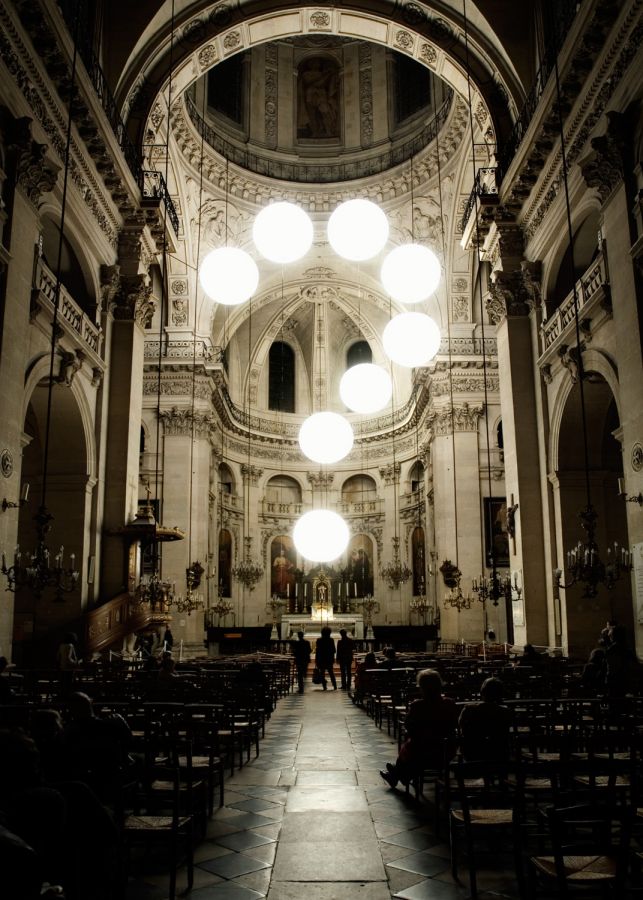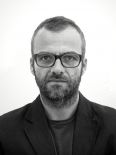Installing a luminous question mark in a church choir amounts to questioning the heart of the mystery - that of existence, origins, religion?It’s essentially an assertion of doubt. It also demonstrates the undeniable importance of religion, and also the sense of bewilderment you experience when faced with the phenomenon as a non-church goer. The installation is reminiscent of the ancient dilemma between scientific certainty and faith. The Church, which is by essence based on faith, has always tried to prove the facts of the Bible through concrete details, such as hyper-realistic representations of Christ’s stigmata. The installation also echoes the Church’s efforts to draw us in by providing answers to our questions. The question mark itself was built according to the laws of anamorphosis. Gradually, as the viewer walks across the church, the typographical sign visually breaks down into multiple luminous floating spheres. The closer you come, the less the question mark is recognizable. And when you return to your starting point, you are faced once more with the symbol, and therefore the question.
When you create an item of furniture (Pools & Pouf! for example, an almost landscaped set of sofas and ottomans), you seem much more interested in the relationship between object and space than in its functionality. Art installations, such as this question mark, are also about creating content and form designed for a specific space. Is the creative process similar?The process is indeed similar in terms of the relationship with space, and the fragmentary aspect both types of work feature. Fragmentation is a technique that allows us to better understand a whole; you could even say that all human action is a manner of fragmenting nature. To me, it represents both the boiling down of a system to an essential form, and a scenario of open potential. With the question mark, the opening is about interpreting a sign; with
Pools & Pouf!, it addresses multiple usage possibilities.
You are sometimes described as a designer, and at other times, as an artist: which of the two do you consider most appropriate? Do you enjoy navigating between them?I am a designer by training, and I feel it’s healthier to try to expand the boundaries of design as they currently stand, rather than styling myself as a designer on one day, as an artist on the next, and so on. Design operates in a relatively pragmatic sphere. I find it fascinating to act within a defined scope and try to find solutions there, but I don’t want to restrict myself to that. I care just as much for the irrational and free element in art: that’s why some of my projects tend to wander around, away from purely pragmatic concerns.
What are your plans for 2012?The scenography for the Autobiographies exhibition at the Espace Culturel Louis Vuitton (March 2012).
The design for two new Corso restaurants in Paris, located Avenue Kléber and Quai de Seine, in March-April.
A stage project at the Pompidou Centre with Philippe Katerine, in September-October.
Limited edition, numbered and signed.

 He’s sometimes described as an artist, and as a designer at other times. Robert Stadler, Austrian-born and now based in Paris, co-founded Radi Designers (1992-2008) and, for the past twenty years, has been developing a body of work that truly defies categorization. Whether for industrial and advertising commissions or in more personal projects, his pieces explore issues of space and functionality always verging on the absurd. In Porte-manteau, he offers a mock half-open door as a coat rack, intended - ironically – to fans of open-plan flats and lofts. With Pools and Pouf!, a sofa and matching cushions spread their black padded leather across the floor. They seem to have been fashioned from a thick matter that looks like a kind of syrupy oil. What are you supposed to do with it? How should you look at it? How can you pigeonhole its evasive shapes?
He’s sometimes described as an artist, and as a designer at other times. Robert Stadler, Austrian-born and now based in Paris, co-founded Radi Designers (1992-2008) and, for the past twenty years, has been developing a body of work that truly defies categorization. Whether for industrial and advertising commissions or in more personal projects, his pieces explore issues of space and functionality always verging on the absurd. In Porte-manteau, he offers a mock half-open door as a coat rack, intended - ironically – to fans of open-plan flats and lofts. With Pools and Pouf!, a sofa and matching cushions spread their black padded leather across the floor. They seem to have been fashioned from a thick matter that looks like a kind of syrupy oil. What are you supposed to do with it? How should you look at it? How can you pigeonhole its evasive shapes?